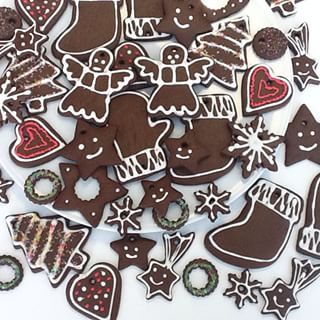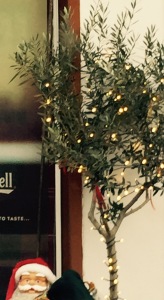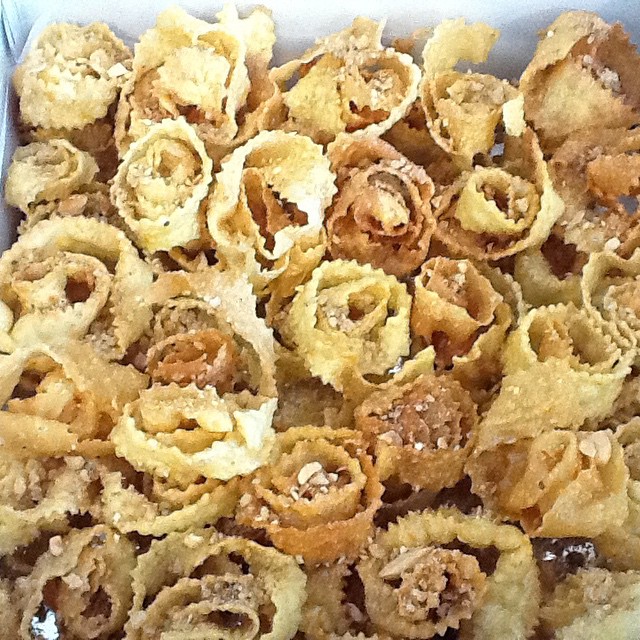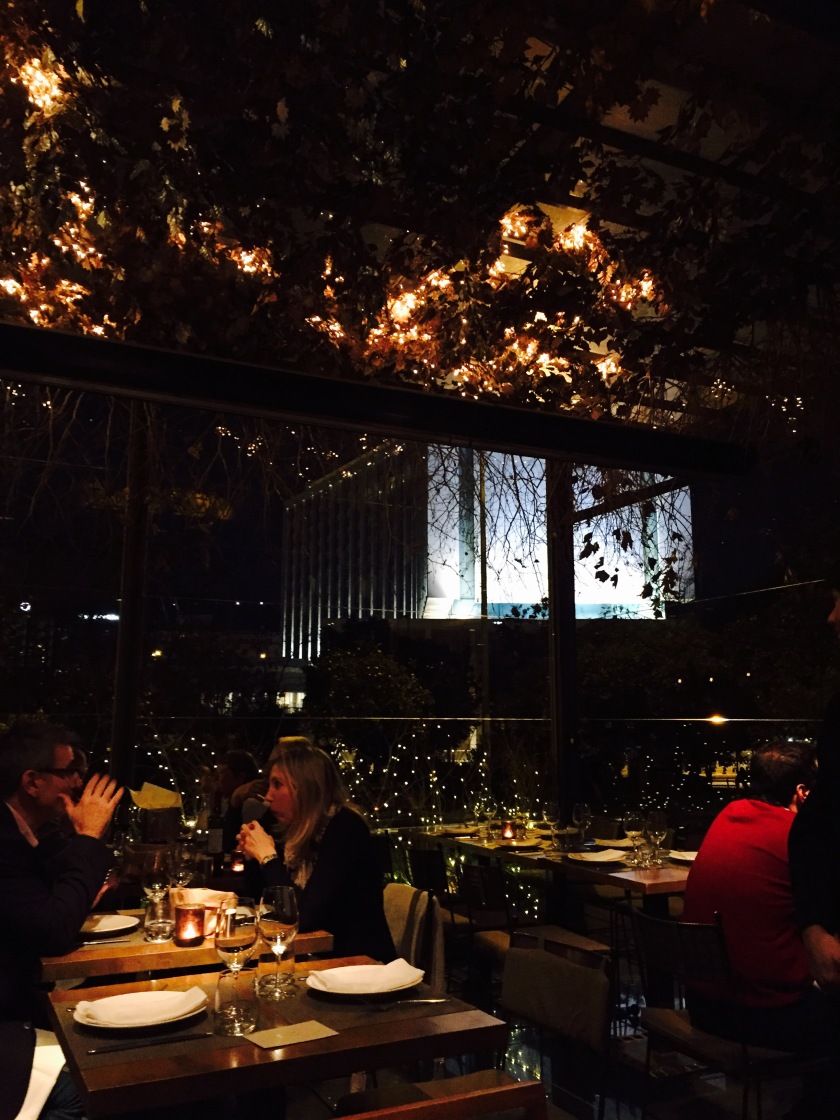In the Greek Orthodox tradition, Christmas ranks second to Easter, but it is still a very important holiday. For the devout it is preceded by a period of fasting so food, unsurprisingly, plays a major role in the festivities. But more of that later.

In Greece, Santa Klaus or Father Christmas is Agios Vasilios (Saint Basil) – so gifts are opened on his name day, January first.
On Christmas Eve and Christmas Day children go from house to house singing the Kalanda (carols whose name comes from the Roman calendae, the first days of the month) and accompanying themselves on small metal triangles and sometimes harmonicas. They knock on doors asking ‘Na ta poume?’ – ‘Shall we say them?’ They are rewarded with money, sweets and sometimes dried figs and other fruit. Then the householders wish them ‘Kai tou xronou’ – ‘Again next year’. They will do the same on New Year’s Eve and New Year’s Day, but the carols are different.
Of course, the quality of the singing varies a lot. I’ve opened my door to blond little angels with voices to match, tinkling away on their triangles – and, a few minutes later, to hulking, spotty teenagers who expected to be paid for playing the Kalanda on their smartphones!
 As far as decorations are concerned, there is the yearly debate of the Christmas tree versus the wooden ship. Changing fashion tends towards one or the other. The modern Christmas tree came to Greece with the country’s first king, Otto of Bavaria, who ascended to the throne in 1833; it did not, however, become popular before the 1940s. Some Greeks still consider it a foreign import, although use of decorated greenery and branches around New Year is recorded as far back as Greek antiquity, and there is evidence that some sort of Christmas tree existed in the Byzantine empire.
As far as decorations are concerned, there is the yearly debate of the Christmas tree versus the wooden ship. Changing fashion tends towards one or the other. The modern Christmas tree came to Greece with the country’s first king, Otto of Bavaria, who ascended to the throne in 1833; it did not, however, become popular before the 1940s. Some Greeks still consider it a foreign import, although use of decorated greenery and branches around New Year is recorded as far back as Greek antiquity, and there is evidence that some sort of Christmas tree existed in the Byzantine empire.
The ship, by contrast, is viewed as a quintessential Greek symbol. Greeks have been seafarers for thousands of years and the country is still one of the world’s leading shipping nations. Children on the islands sang – and are still singing – Christmas carols holding illuminated model boats.
The Christmas ship is made of paper or wood, decorated with small, colorful lamps and a few, simple ornaments. It is usually placed near the outer door or by the fire with the bow pointing to the interior of the house. There are many symbolic connotations attached to it: love of the sea, welcome to those returning from a voyage or honouring of those away at sea and a token offering for their safe return. With golden objects or coins placed in it, the ship also symbolizes a full load of riches reaching one’s home. However, it also has connotations of partings and absent husbands and fathers, and that perhaps is why the tree has found favor with many.

Some households still display the traditional shallow wooden bowl of water with a sprig of basil wrapped around a wooden cross. Once a day, the cross and basil are dipped into holy water and used to sprinkle each room of the house. This ritual is believed to keep the Kallikantzaroi away from the house. Kallikantzaroi are ugly and malevolent sprites which emerge from underground to bring trouble to families.
Outdoors, streets, stores and homes are decorated with garlands of lights and illuminated ships or trees. Town streets are full of people doing their last minute shopping of presents while carols are played everywhere, adding to the festive mood. In most major towns, there are concerts, theatrical performances and other cultural events promising wonderful entertainment.
Each region tends to have its own Christmas traditions. For example, in the villages of northern Greece, the man of the house chooses the sturdiest pine or olive tree branch he can find. This, named Christoxylo (Christ-wood) is put in a newly cleaned fireplace to slowly burn over the whole twelve days of Christmas. This is symbolically meant to warm the baby Jesus in his cold stable, and also to keep out the Kallikantzaroi who supposedly come down the chimney.

A lot of the traditions have to do with food, of course. The Christmas feast is looked forward to with great anticipation by adults and children alike, and especially by those who’ve followed the 40-day Advent fast.
On almost every table there will be a round loaf of Christopsomo (Christ Bread), decorated on the top with a cross, around which are dough symbols representing whatever it is people do in life. Fishermen will decorate the bread with fish, farmers with lambs, and so on.
For starters you might get a fresh, colorful salad of green leaves and red cabbage sprinkled with pomegranate seeds; a lemon-chicken soup called Avgolemono; home-made pies and pastries made with spinach and feta, pumpkin, or meat; or cabbage leaves stuffed with meat and rice, in an egg-and-lemon sauce.
The main dish is pork or lamb, cooked following some regional recipe, or perhaps wild boar; or a roast turkey with a mince, pine nut and chestnut stuffing.
In most parts of Greece, pork was the meat of choice at Christmas, a pig being slaughtered specially for the occasion and cooked in many different ways according to the traditions of the area.

Last, but not least, are the sweets: Diples, crisp fried pieces of dough drizzled with a honey syrup; Melomakarona, made with semolina, cinnamon and cloves, dipped in honey and sprinkled with chopped nuts; Loukoumades, deep-fried puffs of batter also served with honey; and Kourambiedes, buttery, crunchy bites flavored with rose water and dusted with flurries of icing sugar. In the islands they also serve Amygdalota, a kind of almond cookie.

After the meal, at night, some people choose to stay home and watch a Christmas show while others prefer to party the night away in nightclubs and bouzouki joints.
For some great traditional Christmas recipes, click here.
The photographs of the lovely food were kindly supplied by Cake&Cookie co, who make all kinds of delicious cakes, cookies and deserts, and also do catering for various festivities. Go on their site and your mouth will water!


Please, M.L., tell us more about how the Christian holidays are celebrated in your beautiful country. Not only about the dishes to eat but also traditions, games to play and so on. I’m very interested in folklore and ethnology.
LikeLiked by 1 person
I will try and root out some before the New Year!
LikeLiked by 1 person
Thank you so much for this post – loved reading about Greek Christmas traditions -something I knew very little about till now. I feel a bit better educated having read this.One important fact that stuck in my mind: the teenage hulks playing the Kalanda on their mobile phones…
LikeLiked by 3 people
Worse, I’m old enough to remember when they came carrying a battery-operated record player with a scratchy 45rpm vinyl record! Hilarious
LikeLike
What a great read! I lived reading about your Christmas traditions! They are so many differences and similarities as well! Merry Christmas to you!
LikeLiked by 1 person
And the same to you!
LikeLike
M.L. … and absolutely fascinating article. I loved reading it. I was so inspired that I put on some my Hymns of Christmas Eve from the Byzantine Music of the Greek Orthodox Church and read your story again. I love Greece. Thank you.
LikeLiked by 1 person
Thanks, Harold! Glad you enjoyed it.
LikeLike
What a lovely and interesting post!
LikeLike
Thank you, Lynz
LikeLike
A fascinating post. Advent used to be a time of fasting and reflection here, but that seems to have been forgotten.
LikeLiked by 1 person
This was such fun to read! I love hearing how Christmas is celebrated in other countries. So many different traditions, yet many similarities to each other too. Thank you for sharing at the Blogger’s Pit Stop!
LikeLiked by 1 person
Thanks, I’m glad you enjoyed it!
LikeLike
This was wonderful – and made me drool.
LikeLiked by 1 person
Thank you for sharing these traditions. I had no idea… But I love learning about traditions no country, no region, no family seems to celebrate it exactly the same way.
LikeLiked by 1 person
I am not religious but I love all the traditions around Christmas – especially the food! Thanks for this fascinating glimpse into how the Greeks celebrate!
LikeLiked by 1 person
Same here! I’m glad you enjoyed it 💕
LikeLike